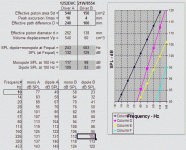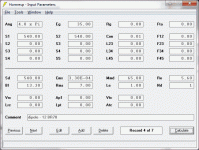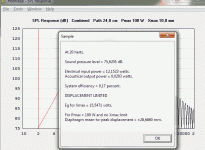If you're referring to the Linkwitz sheet I think you are, isn't that to calculate max output based on volume displacement? That is different than calculating the frequency response. It will likely take different voltage inputs at various frequencies to reach the levels calculated in the Linkwitz sheet while hornresp is calculating the response for a constant voltage at all frequencies. You could try to compare them by calculating the response in hornresp and then running the max spl calculation.
Yes, that's because it requires more and more displacement as frequency decreases to maintain a constant SPL level. If you look at the excursion plot in Hornresp, you'll see excursion is not constant for a constant voltage input. If you are saying that the max spl calculation in hornresp does not match the linkwitz sheet, you have to make sure you're running the calculation after you calculate the combined response.
I did mean the max SPL calculation and I did do the combined response before, yes. I entered the same (dipole) distance in both calculators: 240mm in the sheet and 24cm path length difference in Hornresp.
I did some screens of both:
I did some screens of both:
Attachments
The hornresp number is power limited instead of xmax. It says your xmax is 28.7mm instead of the 10mm you have in the Linkwitz sheet. So it's exactly as one would expect. SPL=67+20*log10(28.7/10)=76dB. Compare that to 75.6dB - pretty close.
Edit - on second look that is not exactly what hornresp is saying.... But something is wrong, and it probably has something to do with the xmax that is assumed.
Edit - on second look that is not exactly what hornresp is saying.... But something is wrong, and it probably has something to do with the xmax that is assumed.
Hi John and vadi,
For the example given, Hornresp assumes that the rear of the diaphragm is the 1.24 metres from the listener and that the mouth of the 0.01 cm long cylindrical horn is 1 metre from the listener (in this case the dipole speaker is actually being modelled as a back-loaded horn system).
For the same example, the Linkwitz spreadsheet assumes that both the front and rear sides of the diaphragm are 1 metre from the listener. The 24 cm path length difference is taken into account when combining the two signals, but not when calculating the absolute SPL at the listening point.
This is why the Hornresp and Linkwitz combined response SPL results are different.
Kind regards,
David
For the example given, Hornresp assumes that the rear of the diaphragm is the 1.24 metres from the listener and that the mouth of the 0.01 cm long cylindrical horn is 1 metre from the listener (in this case the dipole speaker is actually being modelled as a back-loaded horn system).
For the same example, the Linkwitz spreadsheet assumes that both the front and rear sides of the diaphragm are 1 metre from the listener. The 24 cm path length difference is taken into account when combining the two signals, but not when calculating the absolute SPL at the listening point.
This is why the Hornresp and Linkwitz combined response SPL results are different.
Kind regards,
David
Is there any chance of making a future update of HR where the screen can be maximized?
Hi Josh,
Sorry, but the chance of this happening is very small indeed
Kind regards,
David
Last edited:
Have you tried changing your montor's DPI settings to a larger font? On 1 of my monitors, I'm using DVI to HDMI 1080p (1920 x 1080 pixels) and 200% DPI. HR looks 4:3 on the 16:9 screen.David,
Is there any chance of making a future update of HR where the screen can be maximized?
David McBean,
In the new TH Wizard I have found a slight hiccup. When using the Wizard if you set the Variable area sliders to Auto, and then change the section type(Con, Par, Exp) it alters the graphs, but does not change the Auto calculated cells until a change is made to an S or L slider.
The older versions of HR would Auto change the Variable areas with Horn-S2 Variable engaged. It enables fast check in single flare rate horns, among a few other things.
In the new TH Wizard I have found a slight hiccup. When using the Wizard if you set the Variable area sliders to Auto, and then change the section type(Con, Par, Exp) it alters the graphs, but does not change the Auto calculated cells until a change is made to an S or L slider.
The older versions of HR would Auto change the Variable areas with Horn-S2 Variable engaged. It enables fast check in single flare rate horns, among a few other things.
Hi,
Just wanted to post here that I am currently running Hornresp succesfully in Ubuntu 10.10 (recent mainstream Linux operating system), using Wine 1.2.1. I tried it before, but had issues with stability. Now it runs as expected and is reliable. I am well pleased, because it was getting a bit silly to reboot in Windows every time I wanted to fool around with Hornresp.
Ivo
Just wanted to post here that I am currently running Hornresp succesfully in Ubuntu 10.10 (recent mainstream Linux operating system), using Wine 1.2.1. I tried it before, but had issues with stability. Now it runs as expected and is reliable. I am well pleased, because it was getting a bit silly to reboot in Windows every time I wanted to fool around with Hornresp.
Ivo
In the new TH Wizard I have found a slight hiccup.
Hi soho54,
The bug you found has now been fixed. Product Number 2830-110124 refers.
Many thanks for the feedback.
Kind regards,
David
Just wanted to post here that I am currently running Hornresp succesfully in Ubuntu 10.10 (recent mainstream Linux operating system), using Wine 1.2.1.
Hi Ivo,
Thanks for the feedback.
Kind regards,
David
I want to sim some sealed back drivers in a FLH, can that be done in Hornresp?
Hi NEO Dan,
Further to the comments of John and Mark - If the rear chamber size is set to zero, Hornresp assumes that there is no rear chamber and that the rear side of the driver diaphragm is radiating into a solid radiation angle as specified by Ang. In other words, the loudspeaker system is considered to be a back-loaded horn.
To simulate a sealed back driver in Hornresp, a small rear chamber needs to be specified (both Vrc and Lrc must be non-zero).
Kind regards,
David
If you're going to specify a rear chamber in this case, wouldn't a very large rear chamber be the way to go? This would have the least effect on the speaker which is the desired result as opposed to a small rear chamber which would have a large effect on the driver's stiffness and would not be accurate. This is assuming you do not know the T/S parameters of the driver without the sealed rear chamber and don't want to calculate fictitious parameters.
- Home
- Loudspeakers
- Subwoofers
- Hornresp


